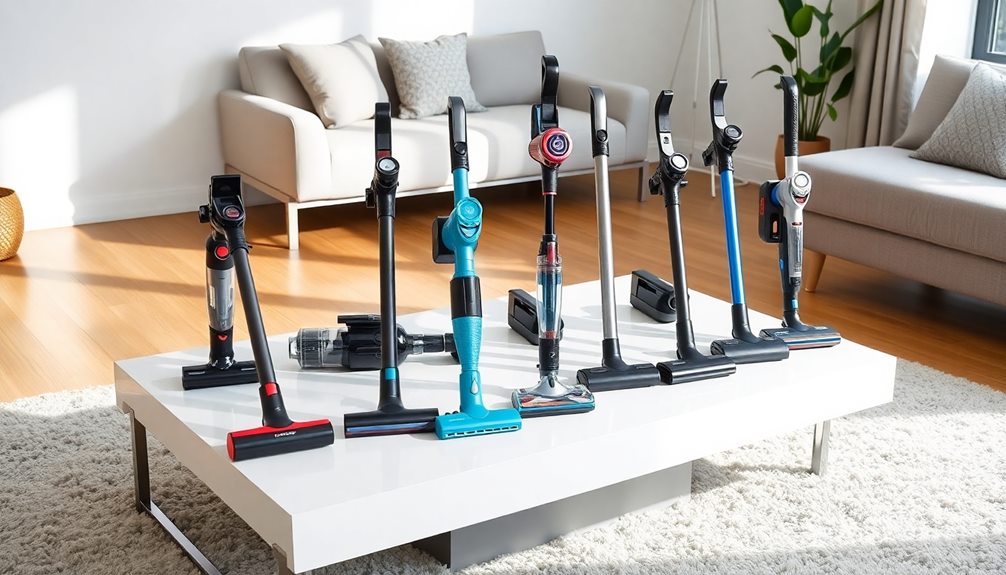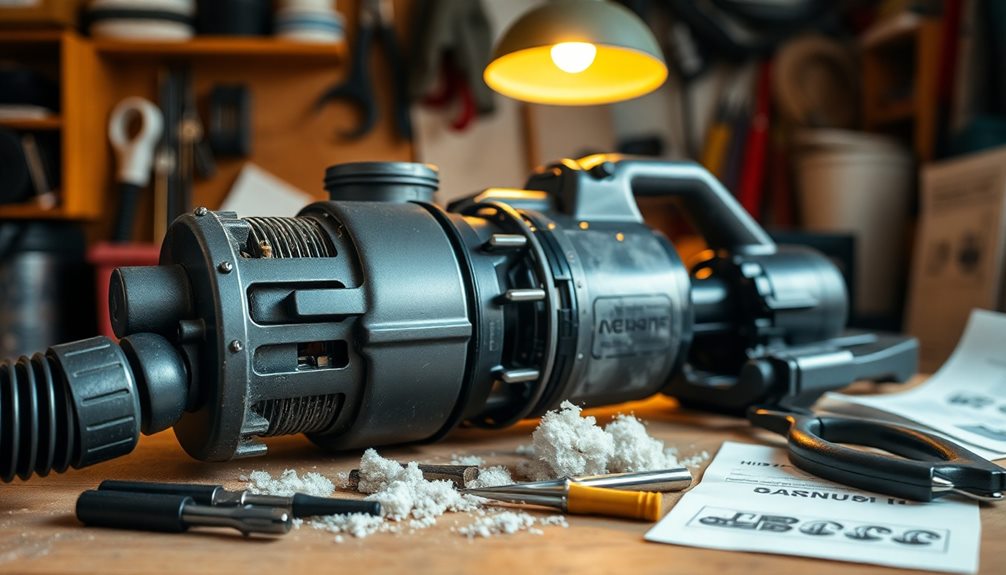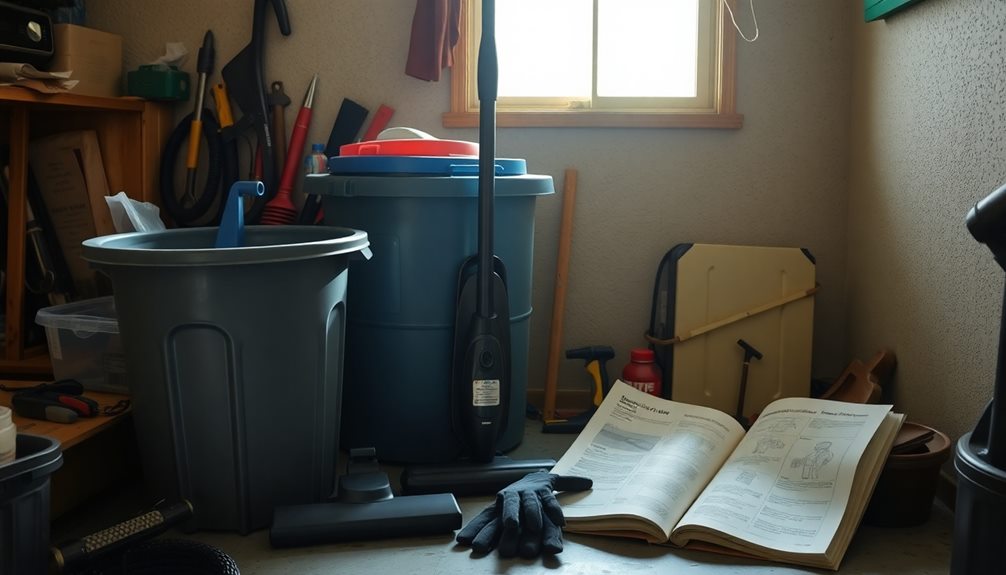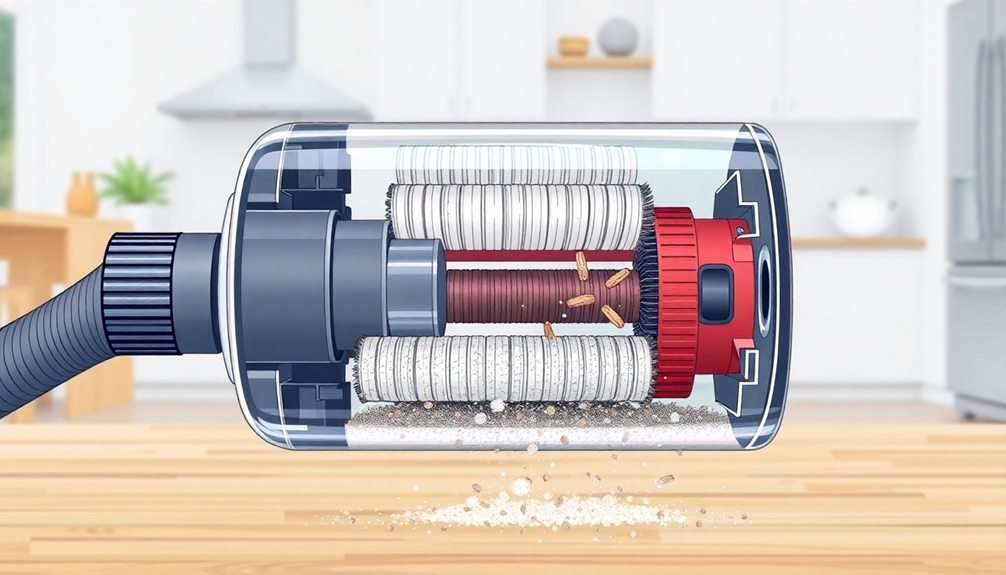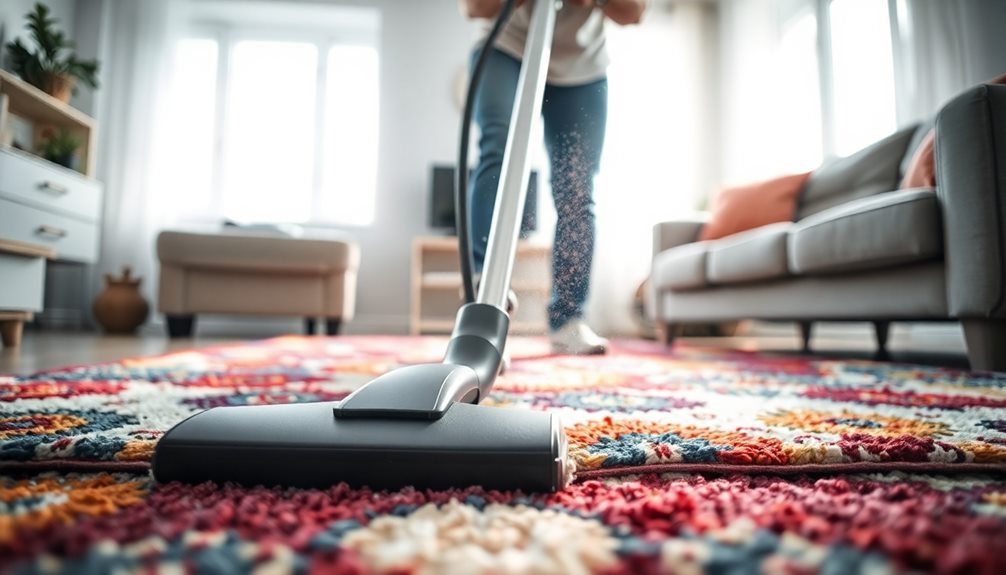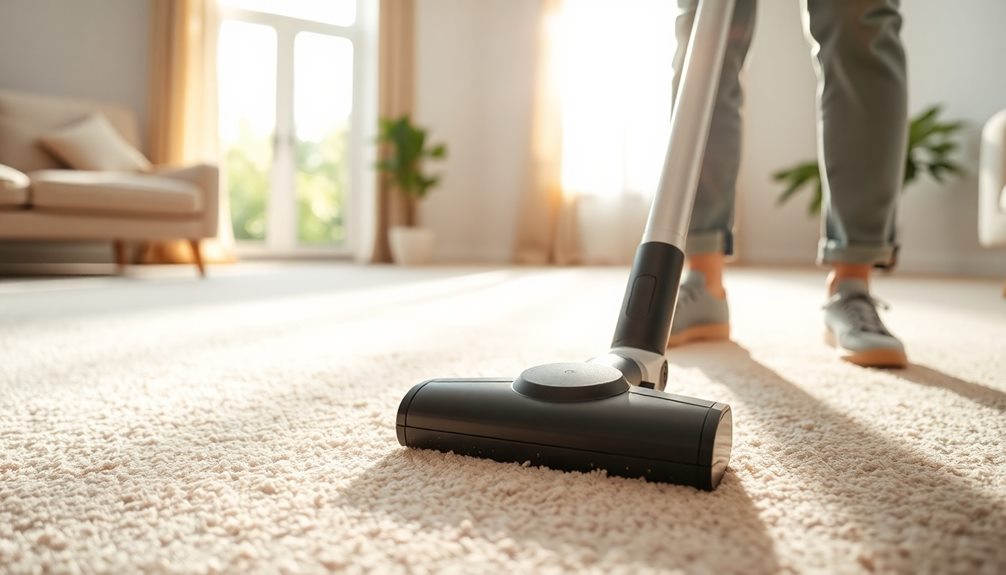To compare cordless vacuum cleaners, start by looking at suction power, measured in air watts; higher numbers mean better performance. Check the battery life, which can range from 30 to 100 minutes, depending on usage. Weigh the models, as lighter ones (4-6 lbs) are easier to maneuver. Also, consider dustbin capacity for less frequent emptying. Evaluate usability features, like swivel heads and attachments for varied cleaning tasks. Finally, gather user feedback to understand real-world performance and challenges. If you keep exploring, you'll uncover valuable insights to help you make the best choice.
Key Takeaways
- Assess suction power in air watts (AW) to determine performance on various debris types, with higher AW indicating better cleaning efficiency.
- Evaluate battery life, considering runtime and recharge duration, as it impacts overall usability during cleaning sessions.
- Consider weight and maneuverability, as lighter models enhance ease of use and reduce user fatigue during extended cleaning tasks.
- Analyze dustbin capacity, as larger bins minimize the frequency of emptying, improving overall convenience while cleaning.
- Review user feedback for insights on real-world performance, common issues, and satisfaction to make informed purchasing decisions.
Key Comparison Factors
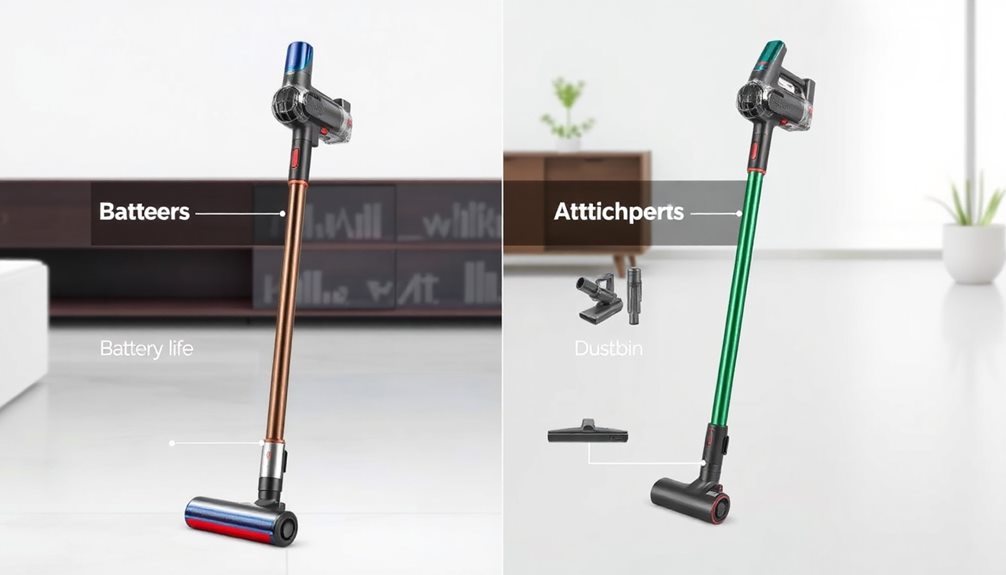
When you're comparing cordless vacuum cleaners, there are several key factors to take into account that can greatly impact your cleaning experience.
First, consider the suction power; you'll want a model that delivers powerful suction, ideally measured in air watts (AW). For example, the Dyson V15 Detect offers an impressive 230AW, making it effective on various surfaces.
Next, look at battery life. It's essential to know how long you can clean per charge, with many models providing 30 to 100 minutes of runtime. The Samsung Bespoke Jet AI stands out by offering up to 100 minutes on its lowest setting.
Weight and maneuverability are also important; lighter models, typically around 4-6 lbs, are easier to move around your home. The design features, like swivel heads, enhance ease of use.
Dustbin capacity shouldn't be overlooked either. Larger dustbins, such as the 27-ounce capacity in the Ryobi 18V One+ HP, mean less frequent emptying during cleaning sessions.
Evaluating Suction Power

Suction power is an essential aspect of cordless vacuum cleaners that directly impacts their cleaning performance. Measured in air watts (AW), higher suction power generally means better capability to tackle various debris types. For instance, the Dyson V15 Detect boasts an impressive 230AW, making it exceptional for thick carpets and larger debris. In contrast, the Tineco Pure One S11, with its 130AW, still performs reliably on hard floors and low-pile carpets.
When evaluating suction power, consider the following factors:
| Cordless Vacuum | Suction Power (AW) |
|---|---|
| Dyson V15 Detect | 230 |
| Dyson V12 Detect Slim | Automatic Adjustment |
| Tineco Pure One S11 | 130 |
| Shark ION F80 | 100 |
| Bissell AirRam | 115 |
Automatic suction adjustment features, like those in the Dyson V12, optimize power based on floor type and dirt level, enhancing overall performance. Remember, the vacuum's design and airflow efficiency also play important roles in how effective it is across different surfaces, ensuring you get the best cleaning experience possible.
Assessing Battery Life

Battery life plays a pivotal role in the usability of cordless vacuum cleaners, as it determines how long you can clean before needing a recharge. Most models offer runtimes ranging from 30 to 100 minutes per charge, considerably influenced by the power settings you choose.
For instance, high suction modes can drastically reduce battery life, affecting your overall cleaning efficiency.
When shopping for the best cordless vacuum, consider the runtime. Higher-end models, like the Dyson V15 Detect, provide up to 70 minutes of runtime, while budget-friendly options such as the Wyze Cordless Vacuum last around 60 minutes.
Additionally, check whether the vacuum features removable and rechargeable batteries, which allow you to swap batteries for extended cleaning sessions.
Recharge time is another key factor; some models, like the Tineco PURE ONE S11, can take up to 4.5 hours to fully recharge. This can impact your vacuum performance if you need to clean frequently.
Understanding Weight and Maneuverability

When you're choosing a cordless vacuum, weight and maneuverability are key factors that can affect your cleaning experience.
Lighter models are easier to handle, especially during longer sessions, while design features can enhance how well you navigate tight spaces.
Understanding these aspects will help you find a vacuum that feels comfortable and efficient for your needs.
Importance of Weight
Weight plays a pivotal role in the maneuverability of cordless vacuum cleaners, directly affecting how easily you can handle and navigate them during cleaning sessions.
Lighter models, like the Dyson Omni-glide at just over 4 pounds, make it easy to clean for extended periods without feeling strained. In contrast, heavier models, such as the Shark Stratos Cordless, can exceed 8 pounds, leading to user fatigue during prolonged use and making it tougher to maneuver in tight spaces.
When choosing a cordless vacuum, consider its weight in relation to your physical capabilities and cleaning needs. Models typically weigh between 4 to 8 pounds; selecting the right one can greatly enhance your satisfaction.
Well-balanced models distribute weight evenly, allowing you to lift and maneuver them around furniture or up stairs with ease. For those with mobility concerns, opting for a lightweight vacuum can minimize strain, making routine cleaning tasks more manageable, especially in multi-level homes.
Ultimately, understanding the importance of weight guarantees you find a cordless vacuum that provides a comfortable cleaning experience tailored to your lifestyle.
Maneuverability Features Explained
Understanding how maneuverability features work can greatly enhance your cleaning experience with cordless vacuum cleaners. The weight of a vacuum plays an essential role in its maneuverability. Lightweight models, like the Dyson Omni-glide at just 4.2 lbs, are typically easier to handle than heavier options, such as the Shark Stratos Cordless.
Design aspects, including swivel steering and a lightweight frame, considerably improve your ability to navigate around furniture and tight spaces. Many models, like the Dyson V15 Detect, strike a balance between weight and suction power, ensuring ease of use without sacrificing performance.
The center of gravity also impacts handling; vacuums with a lower center of gravity tend to offer better stability and easier movement during cleaning tasks.
User feedback consistently highlights maneuverability as a key satisfaction factor, with many users preferring vacuums that are easy to lift and use for longer periods without fatigue.
When evaluating cordless vacuum cleaners, consider how these maneuverability features will affect your cleaning routine, ensuring you select a model that provides both comfort and efficiency.
Reviewing Usability Features
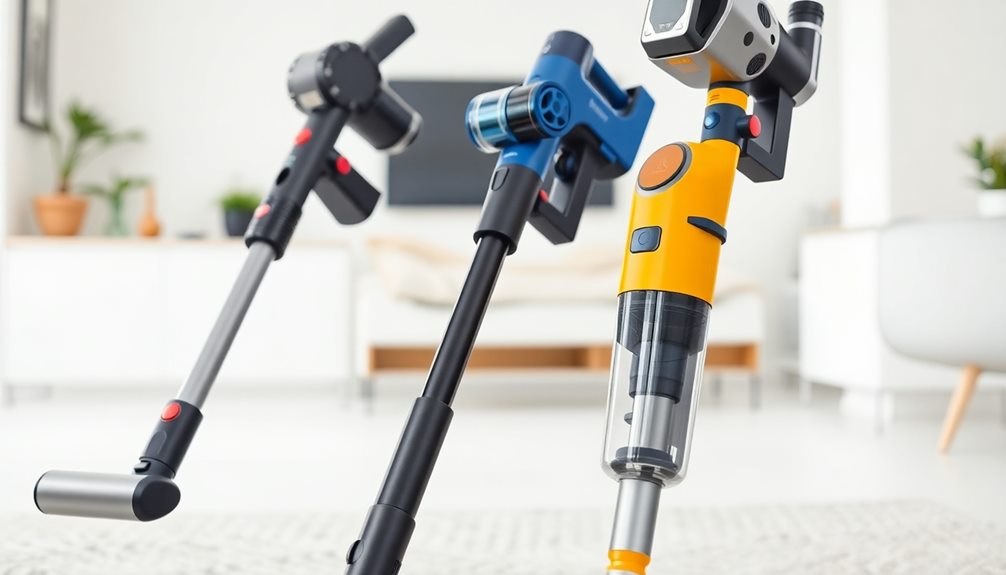
A variety of usability features can considerably enhance your experience with cordless vacuum cleaners. First, consider the weight of the model; lighter vacuums, like the Dyson Omni-glide at just over 4 pounds, improve maneuverability and ease of use, especially for those with mobility concerns.
Battery life and runtime are essential, too—options like the Shark Stratos offer about 60 minutes of use, while the Tineco PURE ONE S11 provides around 40 minutes.
You'll also want to evaluate dustbin capacity. A model like the Ryobi 18V One+ HP, with a 27-ounce dustbin, allows for larger cleaning tasks without frequent interruptions.
Look for additional usability features, such as automatic power adjustment found in the Dyson V15 Detect, which optimizes suction performance based on the surface type.
Analyzing Attachments and Accessories
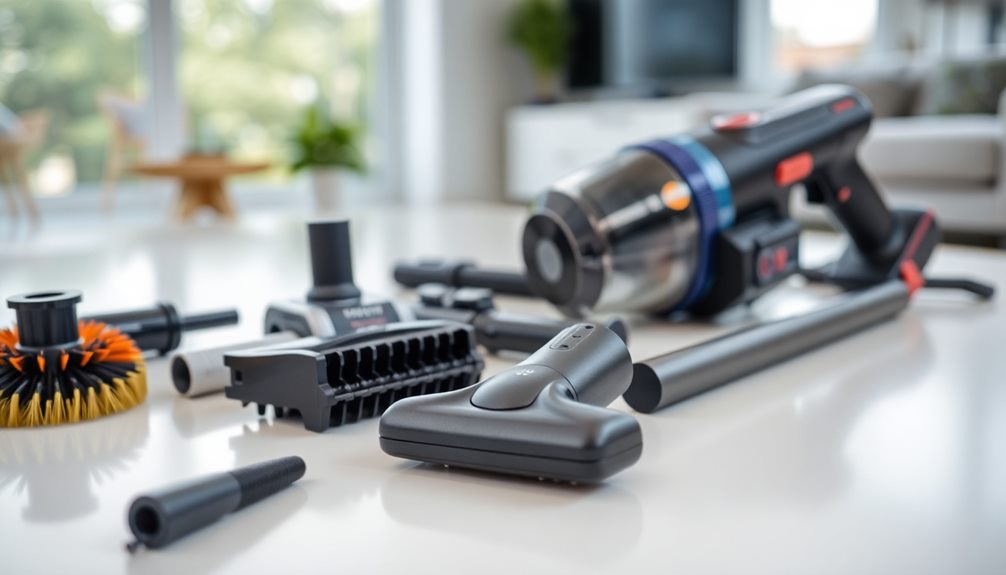
When you're evaluating cordless vacuum cleaners, the variety and functionality of attachments can make a significant difference in your cleaning experience. Look for essential attachments like crevice tools for tight spaces and dusting brushes for delicate surfaces. If you have pets, consider models equipped with motorized pet hair brushes for effective hair removal.
Additionally, some of the best cordless vacuums on the market offer specialized tools designed for efficient dirt removal, ensuring you have the right equipment for every task.
Versatility is key; some vacuums, such as the Tineco PURE ONE S11, offer a combination crevice tool and dusting brush along with a miniature turbo brush to tackle diverse cleaning tasks.
Specialized attachments like upholstery nozzles and odor control cartridges, found in the Shark Stratos Cordless, can enhance your overall user experience.
Don't overlook intelligent accessory integration, which optimizes performance based on your floor type. The Dyson V15 Detect, for instance, features a built-in piezo sensor that adjusts suction automatically.
Also, consider the ease of attaching and detaching tools. Models equipped with quick-release mechanisms, like the Dyson V12 Detect Slim, provide convenience and efficiency during your cleaning sessions.
Gathering User Feedback and Insights
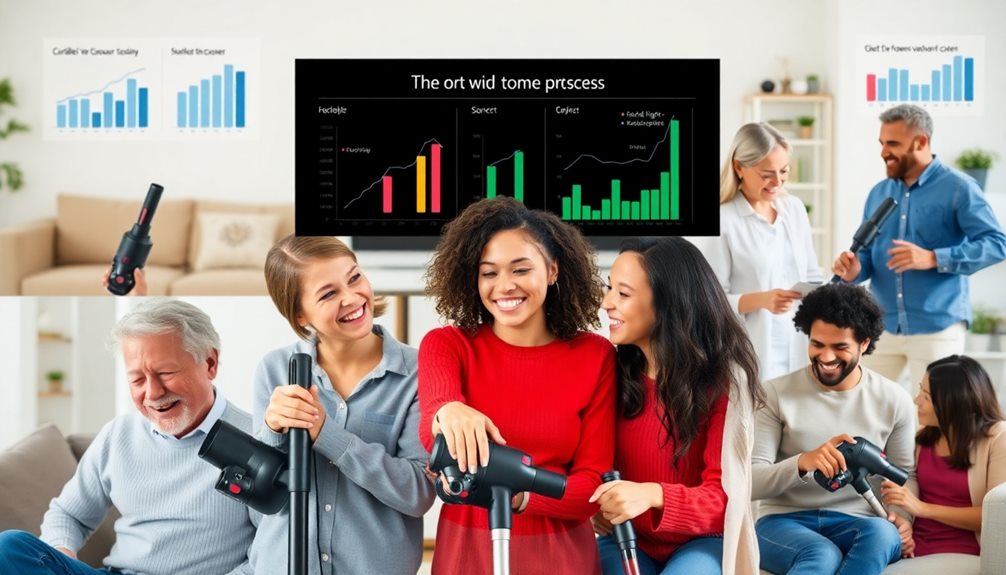
Real user feedback plays a vital role in evaluating cordless vacuum cleaners, as it reveals the everyday performance that specs alone can't convey. To make an informed choice, you should pay attention to online reviews, which often highlight user preferences regarding suction power, battery life, and maneuverability.
For instance, some models may excel in pet hair removal but fall short in dustbin capacity or ease of emptying.
Engaging with user communities, like forums or social media groups, offers valuable insights into the practical use of different models. These discussions can uncover common pain points and unique advantages that may not be apparent in product descriptions.
Additionally, consider filling out surveys or feedback forms yourself to share your experiences and contribute to a broader understanding of consumer insights.
Ultimately, gathering user feedback not only enhances your knowledge but also helps potential buyers make better decisions. By focusing on real-world experiences, you can better assess which cordless vacuum cleaner aligns with your needs.
Frequently Asked Questions
How to Select a Cordless Vacuum Cleaner?
Selecting a cordless vacuum can seem overwhelming, but it doesn't have to be. Focus on suction power, battery life, weight, features, and warranty. These factors will guarantee you find the perfect vacuum for your needs.
What Is a Good Suction Power for a Cordless Vacuum Cleaner?
A good suction power for a cordless vacuum cleaner falls between 130AW to 230AW. If you've got carpets or pets, aim for at least 150AW to guarantee effective cleaning across different surfaces.
How Do You Compare Suction Power of a Vacuum?
Imagine your grandma's old vacuum, struggling with crumbs. To compare suction power, check air watts, consider the debris type, and evaluate how well it performs on different surfaces. Stronger suction means deeper, more effective cleaning.
Is Shark or Dyson Better?
When choosing between Shark and Dyson, consider your needs. Dyson offers superior suction and smart features, while Shark provides longer battery life and budget-friendly options. Your preference for technology versus value will guide your decision.
Conclusion
When you're ready to choose a cordless vacuum cleaner, think of it as finding the perfect dance partner. You want one that moves smoothly with you, has stamina to keep up, and brings the right moves to tackle any mess. By weighing suction power, battery life, weight, usability features, and attachments, you'll find a model that fits your cleaning style. Don't forget to check user feedback—you'll want a partner that others have enjoyed dancing with, too!
